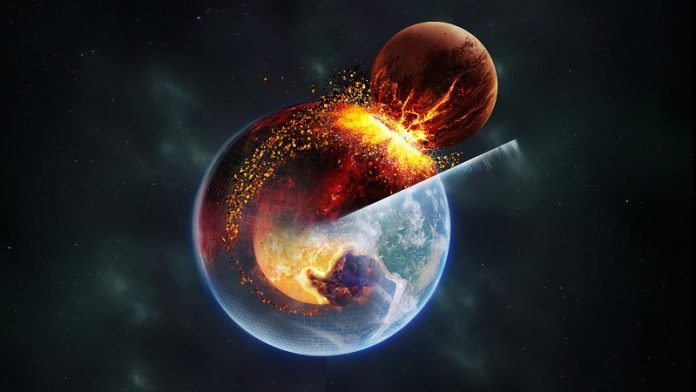
Around 4.5 billion years ago, something dramatic happened in our solar system.
Earth, which was still in its early stages of formation, experienced a massive collision with a Mars-sized body named Theia.
The debris from this massive crash is believed to have come together to form the moon. This is a well-accepted theory, but recent research has added a surprising twist to this story.
Researchers have found evidence that this collision might have also left a lasting mark deep within the Earth itself. Think of it like a scar, but instead of being on the surface, it’s way down in Earth’s mantle.
Here’s what the scientists found:
Different Parts of Earth’s Mantle
After the giant collision, Earth didn’t just mix up uniformly. Instead, it got separated into layers.
The top layer, or the upper mantle, became like a mix of melted rocks from both Earth and Theia.
But the layer below, the lower mantle, remained solid and was mostly from the original Earth.
Mysterious Regions in Earth’s Mantle
Deep within the Earth, there are mysterious regions where seismic waves (like those from earthquakes) slow down.
These regions are called Large Low Velocity Provinces (LLVPs) and exist below Africa and the Pacific plate. The origins of these regions were unknown.
A Clue from Theia
The research team believes that these mysterious LLVPs might have some material from Theia.
After the big collision, some of Theia’s material made its way deep into Earth. Since this material was heavy, it sank to the very bottom. Over billions of years, it grouped together and formed these LLVPs.
Evidence from Iceland and Hawaii
Sometimes, hot currents from deep within Earth rise to the surface, creating islands like Hawaii and Iceland. When scientists studied rocks from these islands, they found gases that don’t match what’s usually on the surface. This means these rocks might have ancient material from the time when Earth and Theia collided.
Discovering Theia’s material deep inside Earth gives us a peek into our planet’s history and the events that shaped our solar system. It’s like finding an old photo album from billions of years ago.
The scientist leading this discovery, Prof. Deng, along with his international team, used super advanced computer simulations to uncover these findings. Their research was not just about our past but also hints at the possibility of understanding planets outside our solar system.
In short, our Earth holds secrets not only of its own history but potentially of other worlds too. The massive collision that created the moon might have changed the surface of our planet, but it also left memories deep within.
The study was published as a featured cover in Nature.
Follow us on Twitter for more articles about this topic.
Source: Chinese Academy of Sciences.



